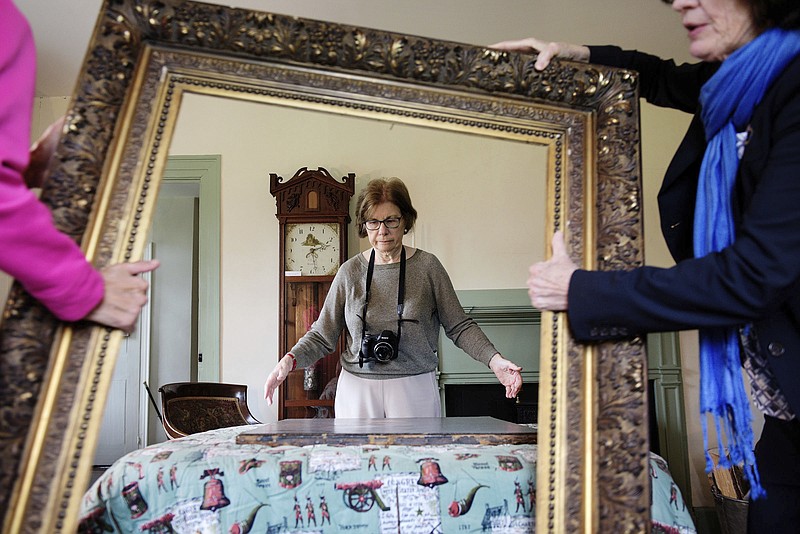HANOVER, N.H.-As soon as the art appraiser finished inspecting the back of the canvas, Cynthia Bittinger and Betsy Gonnerman delicately wrestled the heavy wooden frame upright on the blanket-covered table to reveal the 19th-century oil painting of Daniel Webster, whose fame and importance stand out even when measured against the long list of famous and important Dartmouth College alumni.
Knowing that dropping the recently donated portrait could result in disastrous damage, they gingerly laid the gilded frame on its back, eager for the appraiser, Mary Jane Clark, to continue her work.
Clark's report would determine how much insurance the Hanover Historical Society should purchase for the painting, but Bittinger was more interested in the opportunity to learn more about the history of the society's latest acquisition, including precisely when it was painted.
"Me being a curious person, I've done a lot of research in my life," Bittinger said. "I reached out to people to help me with this."
The research by Bittinger and her network of contacts had ranged from the archives at the Omni Parker House in Boston to the diaries of Webster's wife during a trip abroad to France. A member of the Dunfey family, which used to own the Parker House, donated the painting to the historical society's Webster Cottage Museum, a 1780 farmhouse tucked into the Dartmouth campus along North Main Street, where Webster rented a room for a year before his 1801 graduation.
Bittinger soon established with confidence that the picture was painted by Joseph Desire Court, a French artist whose work was commissioned by Louis-Philippe d'Orleans, reigning king of France from 1830 to 1848.
"But I couldn't see how Daniel Webster and Joseph Desire Court could ever get together," Bittinger said.
No one knows whether Court met Webster, who was born in Salisbury, N.H., in 1782, represented New Hampshire and Massachusetts in the U.S. House, served as a U.S. senator from Massachusetts, ran for president in 1836 and was appointed secretary of state by three different U.S. presidents before his death in 1852.
It's possible that Court, who died in 1865, used a portrait painted by someone else or took advantage of a newly emergent technology-daguerreotypes, the first photographic process that was widely available to the public.
"If it's painted from the daguerreotypes, it's not as valuable," Bittinger said. "But if it's painted from life, it's more valuable."
She hoped that Clark would confirm the painting's authenticity (she'd learned that Court's other paintings sell for anywhere between $4,000 and $22,000) and perhaps give more clues as to the exact date of the painting.
"I'm not an authenticator," said Clark, bending to guide an ultraviolet penlight over the surface of the painting in an inch-by-inch search pattern. "But I'm looking for any signs that there's something quirky, or wrong, just any red flags."
The 68-year-old Clark, of Wilder, has been studying and working in the art world since she was 20, including a stint teaching art history at Dartmouth. Today, she operates Art Care and Appraisals, a Norwich-based firm, to do assessments.
"This pulls together all of the different skills and experience, my teaching, my research, my time studying art history," she said. "I have to draw on every skill I ever learned. It's really something that I couldn't have done when I was 25."
Within just a minute or two, Clark's light revealed a discolored splotch of paint near the bottom of the painting, a vaguely hourglass shape about the size of a finger that is invisible to the naked eye.
"You all can see," she said, playing the light across the blotch, which indicates a difference in the chemical composition of the paint. "This just screams attention. So there's an example of where this painting's been touched up."
The blotch is in the dark brownish background of the painting.
"This is a neutral background. It really doesn't affect the painting much," Clark said. Cracks are common to oil paintings.
"One thing people don't realize is oil takes a long time to dry," said Clark. "It can take up to 50 years."
Different paints, applied to a canvas at different times and in varying thickness, dry at different times, setting the stage for a small-scale version of the frost heaves that can be seen on a blacktopped road.
"It starts tenting, lifting up in different layers," Clark said. "It's called craquelure."
As she made her way up the painting, Clark noted other signs of the restoration, a bevy of discolorations scattered like raindrops around Webster's face.
Though in a sensitive area, they were concentrated mostly in the darkest shadows of Webster's image-the sideburns, the collar, the spots where the dark recesses of his eye sockets blend into his heavy black eyebrows. Clark said they were sparse enough that they wouldn't seriously affect the painting's value.
Paintings of Daniel Webster are not rare at Dartmouth. He posed for many such portraits in the course of his illustrious career as a lawyer and statesman.
"He was so full of himself, you know," Bittinger said. "Dartmouth has so many portraits of Daniel Webster that it's unbelievable. But the quality of this is quite high."
The Hood Museum of Art once assembled dozens of Webster paintings from its holdings into a single exhibit, and today the Class of 1953 Commons (formerly known as Thayer Dining Hall) is dominated by a large painting of Webster arguing before the U.S. Supreme Court in what is known as the Dartmouth College Case.
The painting is captioned with a quote that has become famous for both the man and the college: "It is, sir, as I have said, a small college, and yet there are those who love it."
In the case, a landmark ruling for corporate law, the Supreme Court ruled Dartmouth could not be forced by the New Hampshire Legislature to become a public institution.
Bittinger and Gonnerman, the treasurer of the historical society, began to maneuver the picture back onto its face, gripping the frame and applying upward pressure.
Suddenly, the frame leapt a few inches into the air above the table, leaving the heavy canvas behind on the surface and eliciting soft cries of horror from all three women.
Bittinger and Gonnerman stood, frozen, for a moment, until Clark directed them to lift the frame away to prevent its nails from damaging the canvas.
"It needs to be reinstalled," she said.
Though they had decided not to remove the picture from its frame for fear of damaging the canvas, once it popped out, it proved to be a happy accident, with no discernible damage done to the canvas.
"You're lucky that didn't happen when it was on the wall," said Clark, soon fingering a weak bracket as the culprit.
And then, with the frame out of the way, Clark was able to learn more. She spent minutes peering at the corners and sides of the canvas, trying to make sense of what she saw.
"There's some cardboard," she said. "A spacer, put in there to make it fit snugly."
She soon determined that it was made of Masonite, a substance that wasn't widely produced until 1929.
"So it's not only been touched up, but I think the canvas itself has been remounted to a board," she said.
Bittinger said she hoped to use Clark's final report to help narrow the possible date range of the painting's creation.
A few hours later, Bittinger reported that Patrick Dunfey, the Hood Museum of Art's head of exhibitions, design and planning (and cousin of the painting's donor), was scheduled to reframe the picture in time for it to be placed on the wall during Webster Cottage's next visiting hours, from 2:30 p.m. to 4:30 p.m. on Wednesday.


